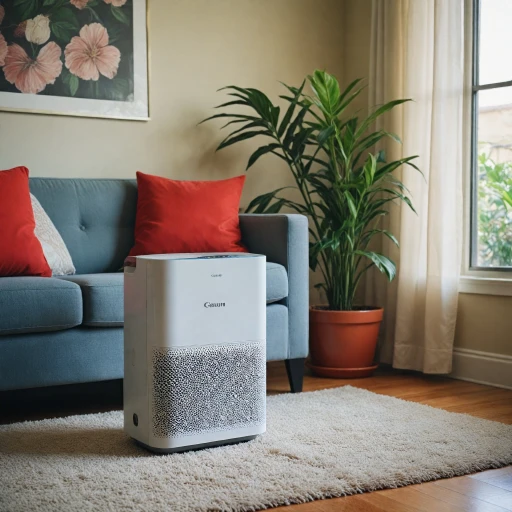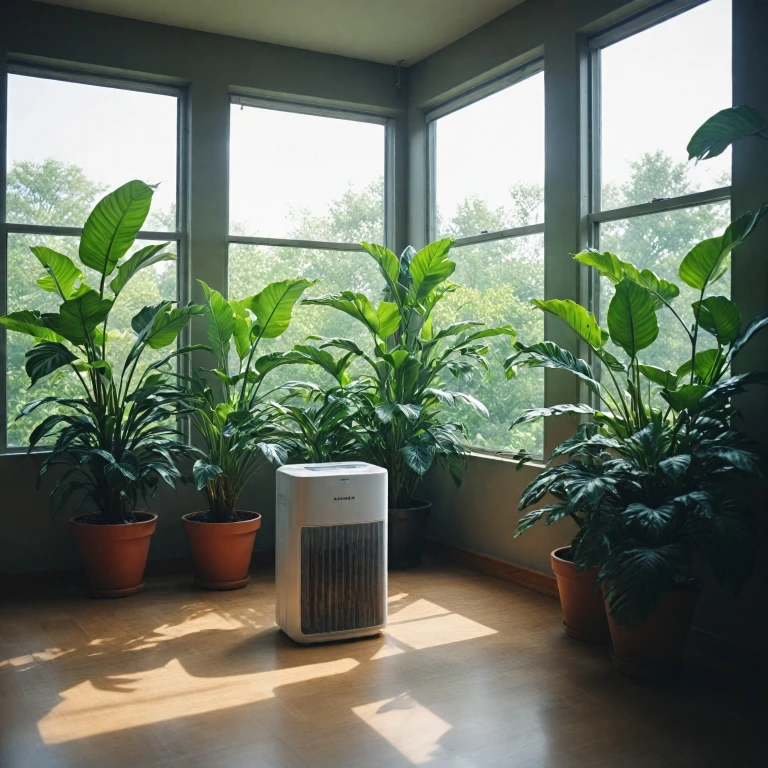The Basics of CO2 Air Purifiers
How CO2 Air Purifiers Integrate with Home Environments
CO2 air purifiers are gaining attention as a modern solution for maintaining optimal indoor air quality. In a world where urban dwellers spend an increasing amount of time indoors, understanding how these devices function can be essential for a healthier living environment.
The fundamental purpose of these air purifiers is to target elevated levels of carbon dioxide (CO2) alongside other indoor pollutants. While various brands offer diverse features, they generally share common technology to enhance filtration efficiency.
Most CO2 air purifiers incorporate multi-stage filtration systems that include HEPA and activated carbon filters. The HEPA filter captures tiny particulate matter, ensuring the air is free from allergens and other airborne particles. Meanwhile, the activated carbon filter targets volatile organic compounds and unpleasant smells, contributing to cleaner and fresher air.
To maximize air quality, the pro air purifiers often come with sensors to monitor CO2 levels and adjust the fan speed for efficient operation. This capability ensures that the purifier operates at optimal capacity, activating a turbo mode or a quieter mini mode depending on air quality conditions.
For pet owners or those worried about specific organic compounds, these devices are particularly beneficial. They can effectively reduce odorous pet-related smells and capture dust from pet fur, improving overall ventilation.
For those considering integrating such devices into their homes, pairing them with a whole-house air cleaner or a humidifier can further optimize indoor air quality. For more insights on combining air purification with humidity control, explore
enhancing indoor air quality with a humidifier and air purifier combo.
Why Monitor CO2 Levels Indoors?
Importance of Monitoring Indoor Carbon Dioxide Levels
Maintaining optimal indoor air quality is crucial, as it's where many people spend a substantial portion of their day. High carbon dioxide levels are not just a concern for ventilation experts but also for anyone striving to ensure a healthy living or working environment.
- Impact on Health and Well-being: Elevated levels of carbon dioxide can lead to discomfort and health issues like headaches, dizziness, and shortness of breath. Prolonged exposure to high carbon dioxide concentration affects cognitive functions, reducing overall productivity.
- Indicator of Poor Ventilation: Monitoring carbon dioxide levels indoors, often with an air purifier, serves as an excellent indicator of inadequate ventilation. Unpleasant smells and the accumulation of volatile organic compounds become prominent when air circulation is compromised.
- Preserving Air Quality: With effective monitoring and control, a CO2 air purifier, often equipped with features like activated carbon or HEPA filters, can significantly enhance indoor air quality. Particulate matter, pet dander, and other pollutants are captured, allowing clean air to circulate.
Beyond its immediate benefits, understanding the role of CO2 air purifiers also aligns with broader efforts to enhance air quality found in more detailed resources like
air-purifying bags that can complement the filtration process. Monitoring and controlling carbon dioxide levels indoors is not just a matter of comfort; it's an essential aspect of a healthier indoor environment.
How CO2 Air Purifiers Work
Unlocking the Mechanism: How CO2 Air Purifiers Operate
The process behind CO2 air purifiers is both intriguing and essential for enhancing indoor environments. These devices work tirelessly to maintain optimal air quality amidst elevated levels of carbon dioxide and other pollutants that can compromise our breathing space.
CO2 air purifiers predominantly focus on filtering, as well as utilizing specialized components designed to elevate air quality. One of the principal methods they employ involves a combination of filters, including HEPA and carbon filters. The HEPA filter is renowned for capturing particulate matter, which includes dust, pollen, and pet dander, contributing to a cleaner, healthier environment.
Similarly, activated carbon filters uniquely capture volatile organic compounds (VOCs) and absorb unpleasant smells, which are common in tightly enclosed areas. This dual-filtration system is crucial in purifiers as it addresses both gases and particulate pollutants. For many, this combination of filtration represents a pro move in maintaining elevated levels of clean air.
Furthermore, the integration of sensors plays a pivotal role in these air purifiers, providing real-time monitoring of CO2 levels. Once elevated levels of carbon dioxide are detected, the device automatically adjusts its fan speed and filtration mode accordingly. Some advanced models even feature a mini display that allows users to track air quality data and adjust settings, ensuring efficient airflow distribution across the width of a room.
For optimal performance, regular maintenance, such as replacing the
air purifier filter, is essential. This process ensures that your air purifier continues to operate efficiently and effectively, retaining its ability to enhance indoor air quality.
Through these sophisticated mechanisms, CO2 air purifiers contribute significantly to ventilation and circulation, ultimately paving the way for a breath of fresh, healthy air indoors.
Benefits of Using CO2 Air Purifiers
Advantages of Employing CO2 Purifiers
Utilizing a CO2 air purifier offers a multitude of benefits, particularly when it comes to maintaining optimal indoor air quality. While general air purifiers primarily target particulate matter, such as dust and pollen, CO2 purifiers address the carbon dioxide levels that can significantly impact one’s well-being.
Firstly, these purifiers effectively reduce elevated levels of CO2 indoors, contributing to a healthier environment. When carbon dioxide accumulates, it can lead to a stuffy atmosphere and even induce symptoms like headaches and fatigue. By maintaining ideal CO2 levels, occupants can experience improved comfort and concentration.
Additionally, CO2 air purifiers aid in minimizing unpleasant smells that often accompany poor ventilation. They work by integrating filtration and ventilation systems to circulate clean air and refresh the indoor space.
Moreover, many models come equipped with features such as activated carbon filters and HEPA filters. These elements not only target CO2 but also trap volatile organic compounds and other airborne pollutants. As a result, the overall air purification process is more comprehensive, offering protection against a variety of indoor contaminants.
Furthermore, advanced purifiers often include adjustable fan speeds and modes, catering to different needs and preferences. Whether it's a mini air purifier for a small space or a pro air model for larger areas, there are options to suit different requirements.
For pet owners or those dealing with smoke and other pollutants, the integration of activated carbon filters, mentioned further in our exploration of how CO2 air purifiers work, is particularly beneficial. These filters excel at absorbing odors and chemicals such as carbon dioxide, ensuring that even homes with pets maintain high air quality standards.
Integrating a CO2 air purifier is an excellent step towards achieving cleaner, healthier indoor air. With their ability to address potential air issues and offer adjustable features for enhanced control, these purifiers are a valuable investment for any home.
Choosing the Right CO2 Air Purifier
Selecting the Ideal CO2 Air Purifier
Choosing the right CO2 air purifier for your needs involves several factors to ensure effective indoor air quality improvement. Here's what you should consider:
- CO2 Levels and Room Size: Start by assessing the carbon dioxide levels in your indoor space and the size of the room where the purifier will be used. This will help determine the purifier's capacity and the width of coverage needed. Consider a mini portable purifier for smaller rooms or a powerful air pro model for larger areas.
- Filtration Technology: Look for purifiers that incorporate activated carbon and HEPA filters, both of which are essential for effective filtration and removal of particulate matter and volatile organic compounds. Carbon filters are particularly effective at eliminating unpleasant smells and pet odors.
- Fan Speed and Modes: Models with adjustable fan speeds and operating modes, like night mode or automatic settings, provide flexibility to adapt to current air quality needs without excessive noise.
- Ventilation and Air Circulation: Ensure the purifier aids in proper ventilation, as it helps maintain lower CO2 levels indoors and achieves cleaner air through better air circulation.
- Design and Aesthetics: While performance is crucial, the purifier's design should complement your living space. Options come in various finishes, including sleek white looks that blend with most decors.
Selecting the right CO2 air purifier means balancing functionality with your particular indoor requirements, ensuring a significant improvement in air quality by maintaining optimal carbon dioxide levels.
Maintenance and Care for CO2 Air Purifiers
Essential Tips for Caring and Maintaining Your CO2 Air Purifier
For those investing in a CO2 air purifier to maintain optimal indoor air quality, understanding the necessary care and maintenance procedures is crucial to ensure the purifier operates efficiently. Here are some tips to help you keep your device in top condition:
- Regularly Check and Replace Filters
- The purifier filter, particularly the activated carbon and HEPA filters, plays a significant role in trapping particulate matter and volatile organic compounds. Over time, these filters can become clogged, reducing their effectiveness.
- Most air purifiers come with indicators to alert you when it's time to replace the carbon filter or HEPA filter. Keep an eye on these indicators to maintain clean air indoors.
- Monitor and Adjust Fan Speed and Modes
- Depending on the level of carbon dioxide and other pollutants, adjusting the fan speed to a pro air mode can enhance performance. Many air purifiers offer a range of settings; you should select the mode that best suits your current needs.
- Ensure Proper Ventilation
- Even with a high-quality air purifier, proper ventilation is essential. Adequate indoor ventilation helps maintain balanced levels of gases.
- Clean the Exterior Regularly
- Air purifiers can accumulate dust on their exterior surfaces. Regularly wiping the width and mini components with a damp cloth helps prevent dust buildup.
- Mind Pet Hair and Dander
- If you have pets, their fur and dander can affect the quality of air and the performance of filters. Regular vacuuming around the purifier and using a purifier with a pet mode can manage this issue.
A well-maintained CO2 air purifier will serve you reliably, ensuring that your indoor space remains healthy by effectively reducing unpleasant smells and keeping air pollution in check.

